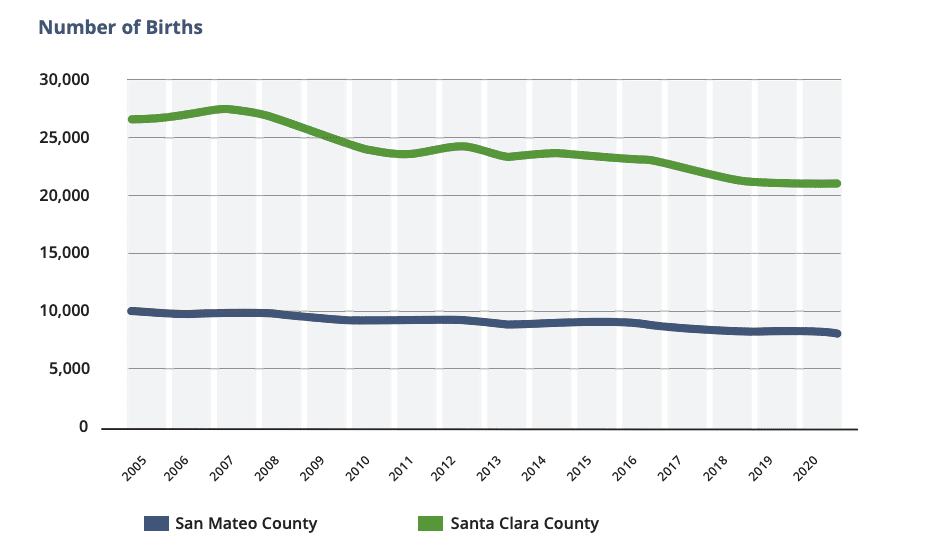Two pernicious problems in Silicon Valley—lack of affordable housing and declining school enrollment—are closely tied, new research suggests.
A recent report commissioned by the nonprofit Silicon Valley Community Foundation says building more housing could help reverse long-term declines in student enrollment across Santa Clara County. Enrollment is expected to decline by more than 15% in the county over the decade—dropping from 253,625 students in 2020-21 to 212,501 students by 2030-31.
The report’s collaborators say they want to convince people that more housing will help revive struggling school districts. They say it’s critical to address this as many cities in the South Bay are actively updating plans for where to prioritize building new homes, and many local officials aren’t aware that these issues are linked.
“It’s not on the city radar when they are doing housing site inventory, as far as I can tell,” Stephen Levy, author of the report and director at the Center for Continuing Study of the California Economy, told San José Spotlight. “No one thinks of looking at whether a school district could really benefit from added students and added housing.”
California requires cities to update their plans for housing every eight years. The so-called housing element update is vetted and approved by local officials in a process that may take more than a year. These updates are designed to meet a state goal set in 2020 to build more than 441,000 across the Bay Area over the next eight years.


All the cities in Santa Clara County need to collectively build 129,577 homes of all income levels by 2031, with San Jose responsible for 62,200 homes.
The report—developed in partnership with Silicon Valley@Home and Palo Alto Forward—focuses on five cities that are in the middle of updating their housing plans: Cupertino, Menlo Park, Mountain View, Palo Alto and Sunnyvale. SV@Home and Palo Alto Forward are housing advocacy organizations.
According to the report, all of these cities are experiencing steep declines in student enrollment. In Cupertino, enrollment in elementary schools has fallen 17% since 2014-15. In Palo Alto, it’s dropped 28% over the last six years.
According to the report, this trend is driven by a long-term drop in birth rates, but also the more immediate problem of unaffordable housing. According to the U.S. Census Bureau, there has been a steady decline in birth rates across the country since 2008.


“It’s very difficult for a young family to purchase a single-family home in Silicon Valley,” Mathew Reed, policy director for Silicon Valley@Home, told San José Spotlight. “Some of the areas that haven’t been targeted for increased housing are areas that have seen the greatest decline in enrollment.”
Santa Clara County is home to some of the most expensive places to live in the country. A growing number of residents are unable to afford to live in the region, and cities are struggling to build homes accessible to people with low and moderate income. State laws meant to expand local housing, such as a policy that allows homeowners to split their lots and build more homes, have been met with fiery opposition in San Jose and elsewhere.
Claudia Rossi, a trustee on the Santa Clara County Board of Education and candidate in the county’s Board of Supervisors District 1 race, said this trend is contributing to a mass exodus of lower-income families. Losing them has a direct impact on school districts, she added.
“You have to have a certain number of students to also be able to employ a certain number of teachers, so with declining enrollment comes job cuts,” she told San José Spotlight. “If declining enrollment meets a certain point, you’re looking at school closures—it’s a domino effect.”
This is already happening in the county. Last year, the Alum Rock Union School District board voted to close two middle schools after noting that enrollment is expected to drop by 50% by 2027.
Levy said one goal of the report is to refute an anti-housing argument that adding more homes to a community will overburden local schools. San Jose Councilmember Dev Davis, who is running for mayor, is fighting a state law that makes it easier to build more densely in single-family neighborhoods, saying it will overburden local infrastructure, including schools.
“I personally think that school quality and changing demographics has a bigger impact on the enrollment declines than the state of the housing market,” Davis told San José Spotlight. “A lot of people vote with their feet, and send their kids to private school, if they have that option available to them.”
Gina Dalma, an executive vice president at the Silicon Valley Community Foundation, told San José Spotlight she hopes the report will inspire community members—especially people who already care about school issues—to see these two issues as interlinked.
“If you call yourself an educational advocate, make sure you’re involved in housing,” Dalma said.
Contact Eli Wolfe at [email protected] or @EliWolfe4 on Twitter.
Editor’s Note: Due to a source error, a previous version of this story cited an incorrect percentage for the student enrollment decline in Palo Alto schools.



Leave a Reply
You must be logged in to post a comment.